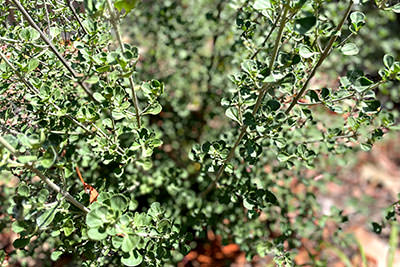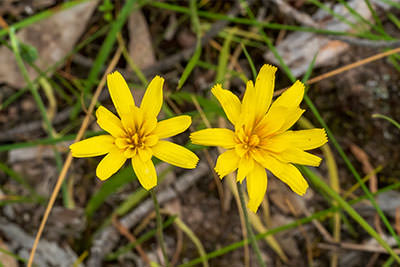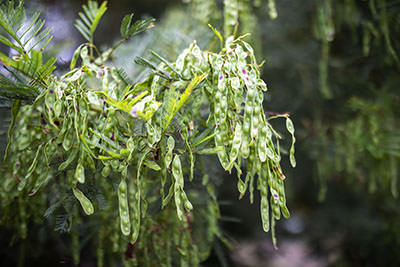LEARNING ACTIVITY
STORY
The school garden was now well established and Jarrah was also growing. He was now the custodian of the knowledge that Adam had taught him. Jarrah observed his young cousin Ricky walking into the garden. Jarrah was shocked to see Ricky start to pull up all the Salt bush!
“Ay Rick what ya doing! You going to take all that?” Jarrah said angrily. “Yeah why not! We need it for our cooking project I want to have enough for the class” Ricky said.
Jarrah replied: “First of all, you have more than enough in your bucket already, you’re just being greedy now. Remember, we only take what we need and not what we greed! By doing this, we ensure this plant continues to thrive and can put out its seeds so that there is plenty for all of us. If you take all that plants now, the next generation that come to the school won’t have a chance to learn about this plant and why it’s important to us.”

The satisfaction of eating straight from the garden is one of life’s best learning experiences, however we need to be respectful and mindful to only harvest what we need to allow the plant to continue to thrive for generations to come.
This activity involves the assessment and mapping of local environments to create a successful and thriving Indigenous plant-use garden.
To understand local perspectives and support these activities, we recommend reaching out to the local Traditional Owners and First Nations peoples community groups who can assist in knowledge sharing and understanding local land, histories and culture. This is an important consideration to ensure that any reconciliation initiatives are being driven in a local, meaningful way.
This learning activity is the last part of a sequence of 6 individual learning activities focused on creating an Indigenous plant-use garden. The order of these learning activities are: resources from the bush, vision, plant list, site assessment, planting and harvesting.
For children to:
- understand the steps in harvesting and processing plants in an Indigenous plant-use garden
- follow sustainable practices for harvesting
- be productive and active outdoors while building social and teamwork skills
- value Indigenous harvesting practices and the benefits of sharing amongst the community.
Each plant and their plant parts will be ready to harvest at different times and during different seasons. Harvest times is also dependent on local conditions.
Introduction
Harvesting your native produce will not only provide the experience and joy of growing your own edible plants, but also provide a deeper understanding of First Nations peoples culture and histories.
Checklist
Instructions
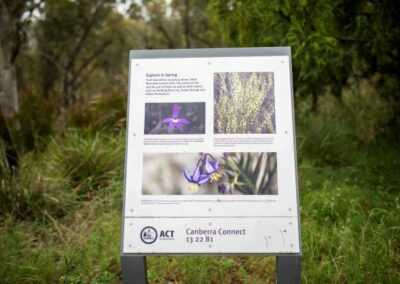
STEP 1
Plan
Begin this activity at your location with an Acknowledgement of Country. By acknowledging the land, you are also making a promise that you will care for the Land, the waterways, the plants and the animals.
Use your plant labels and garden guides along with onsite monitoring to determine the best time to harvest your plants. Timing may vary, for example, you may need to harvest in your school garden before holiday periods.
Ensure you have your collection resources ready and revise safe harvesting techniques. Wear protective footwear, use safe lifting procedures and look for spiky plant material and insects when harvesting.
Use the activity sheet to record each step of harvesting, describe what is happening.
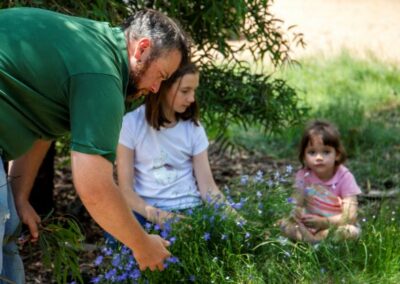
STEP 2
Collect
Examine your produce for any disease or insect damage before harvesting.
A sustainable practice is to take what you need, and not what you greed. This ensures that there is always something left for the animals, the next person and the next time.
Fruits, nuts and seeds can be picked carefully by hand whilst root vegetables may need to be pulled gently from the soil using a trowel or spade to loosen the soil. Blady grass material will need to pulled gently or cut off near the base.

STEP 3
Clean
Clean produce is important for healthy eating.
Make sure you wash your hands using soap or sanitiser before cleaning or eating your collected produce.
Once collected, use water to wash your produce. Using a colander, bucket or similar container.
Place your washed produce on a paper towel or clean tea towel so the produce can dry off naturally.

STEP 4
Share
You may like to use scales to weigh your harvest before you divide the produce equally. Containers or paper bags will help to easily distribute the produce. Use the activity sheet to help children devise ideas to get the most out of their harvest.
Discuss:
- What part of the plant have you harvested?
- What is your plant harvest going to be used for?
- How would you prepare your plant material for use?
- What have you done to ensure you have harvested your produce sustainably and in a way that supports caring for Country?
Complete the activity sheet to record your learnings.
Extension Activity
Extension 1
Create a harvest schedule for your Indigenous plant-use garden and record what month and plant part you will be harvesting.
Extension 2
Imagine you have a native food restaurant what would you serve? Design a two course meal using ingredients from your Indigenous plant-use garden.
Curriculum and Framework Links
Check the curriculum authority for your state or territory for Aboriginal and Torres Strait Islander specific subjects. This may also include training organisations.
GEOGRAPHY
Year 7: ACHGK045
Year 8: ACHGK049
Year 9: ACHGK061, ACHGK062, ACHGK064, ACHGK067
Year 10: ACHGK070, ACHGK071, ACHGK072, ACHGK076
HISTORY
Year 7: ACOKFH003, ACDSEH031
Year 9: ACDSEH085, ACDSEH020
DESIGN & TECHNOLOGIES
Years 7 & 8: ACTDEK032, ACTDEK033
SCIENCE
Year 7: ACSSU112, ACSSU116, ACSHE223, ACSHE121
Year 8: ACSHE134, ACSHE226
Year 9: ACSSU176
VISUAL ARTS
Years 7 & 8: ACAVAM118, ACAVAR124
Years 9 & 10: ACAVAM125, ACAVAR131
EARTH & ENVIRONMENTAL SCIENCES
Year 11: ACSES011, ACSES040
Year 12: ACSES066, ACSES077, ACSES081
BIOLOGY
Year 11: ACSBL011, ACSBL019, ACSBL020, ACSBL009, ACSBL011
GENERAL CAPABILITIES
Critical and Creative Thinking
Personal and Social Capability
Ethical Understanding
Intercultural Understanding
CURRICULUM CONNECTIONS
Outdoor Learning
CROSS CURRICULUM PRIORITY
Aboriginal and Torres Straight Islanders Histories and Cultures
Sustainability
Reference List
Complete the Whose Country are you on? A learning activity to determine the local First Nations language groups.
ONLINE RESOURCES
Aboriginal Plant use in South Eastern Australia and Aboriginal Plant use and technology, from the Australian National Botanic Gardens provides some insightful and educational information that will assist in completing this learning activity.
Guide to the Aboriginal Garden Monash University is an excellent guide providing a detailed listing of plants and their use from Monash University.
The Care for Country RAP (Reconciliation Action Plan) Action and Caring for country (Secondary) curriculum resource on the Narragunnawali platform provides resource material for students and teachers to build a personal sense of responsibility for respecting and caring for the Country/place around them, the while building an awareness and appreciation of Aboriginal and Torres Strait Islander contributions to sustainable land management
WATCH
This selection from ABC Education provides insights on the following:
How to harvest and cook Murnong (3 and a ½ minutes); how to harvest and eat Warrigal Greens (1 minute), discover more about plants used by First Nations Peoples and native Australian bush foods (4 minutes), Respecting the bush harvest (3 and a ½ minutes) explores the interest in ‘bush tucker’ and how it generates a greater understanding of First Nations Peoples cultural identities.
READ
Guide books for your local area.
Field guide to Useful native plants from temperate Australia, Judith Caton & Richard Hardwick, Harbour Publishing House, 2016 provides very useful visual information along with growing conditions and First Nations peoples uses for plants in temperate areas.
This selection of books gives more detailed information on Australian native plants, their traditional uses and modern uses and recipes.
- The oldest foods on Earth, John Newton 2019 published by NewSouth Publishing
- Grow your own bushfoods, Keith and Irene Smith, 2013 New Holland Publishers
- Australian Native Food Harvest, Julie Weatherhead, 2016 published by Peppermint Ridge Farm.
NETWORK
We recommend reaching out to the Local Traditional Owners and First Nations peoples community groups who can assist in knowledge sharing and understanding local land, language, stories and culture. To reach out or find contacts in your local community you could speak to parents of First Nations students, to an Indigenous Learning Officer (ILO) at your school, local Land Council or a local Landcare group. Engaging with these resources can contribute to a wider school and community reconciliation initiatives, including a schools Reconciliation Action Plan (RAP).
We have some suggested organisations to approach listed on our Junior Landcare Community Page and in more detail within our Educator Notes.
Why not try one of our other Junior Landcare learning activities?
Creating an Indigenous plant-use garden: plant list
First Nations Perspectives
Creating an Indigenous plant-use garden: resources from the bush
First Nations Perspectives
Love Letters to the Land
Biodiversity|First Nations Perspectives|Food Production|Waste Management
Creating a yarning circle: involving First Nations people
First Nations Perspectives
